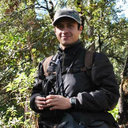[Nesting habitat characterization for Amazona oratrix (Psittaciformes: Psittacidae) in the Central Pacific, Mexico].
Keywords
Abstract
The nesting requirements of the Yellow-headed Parrot (Amazona oratrix) are poorly understood, despite their broad historical distribution, high demand for pet trade and current endangered status. Information concerning their nesting requirements is required in order to design specific restoration and conser- vation actions. To assess this, we studied their nesting ecology in the Central Pacific, Michoacan, Mexico during a ten year period. The analyzed variables ranged from local scale nest site characteristics such as nesting tree species, dimensions, geographic positions, diet and nesting forest patches structure, to large scale features such as vegetation use and climatic variables associated to the nesting tree distributions by an ecological niche model using Maxent. We also evaluated the parrot tolerance to land management regimes, and compared the Pacific nest trees with 18 nest trees recorded in an intensively managed private ranch in Tamaulipas, Gulf of Mexico. Parrots nested in tall trees with canopy level cavities in 92 nest-trees recorded from 11 tree species. The 72.8% of nesting occurred in trees of Astronium graveolens, and Enterolobium cyclocarpum which qualified as key- stone trees. The forests where the parrots nested, presented a maximum of 54 tree species, 50% of which were identified as food source; besides, these areas also had a high abundance of trees used as food supply. The lowest number of tree species and trees to forage occurred in an active cattle ranch, whereas the highest species rich- ness was observed in areas with natural recovery. The nesting cavity entrance height from above ground of the Pacific nesting trees resulted higher than those found in the Gulf of Mexico. We hypothesize that the differences may be attributed to Parrot behavioral differences adapting to differential poaching pressure and cavity avail- ability. Nesting trees were found in six vegetation types; however the parrots preferred conserved and riparian semi-deciduous forest for nesting, with fewer nests in deciduous forest, while nesting in transformed agricultural fields was avoided. The main climatic variables associated with the potential distribution of nests were: mean temperature of wettest quarter, mean diurnal temperature range, and precipitation of wettest month. Suitable cli- matic conditions for the potential presence of nesting trees were present in 61% of the region; however, most of the area consisted of tropical deciduous forests (55.8%), while semi-deciduous tropical forests covered only 17% of the region. These results indicated the importance to conserve semi-deciduous forests as breeding habitats for the Yellow-headed Parrot, and revealed the urgent need to implement conservation and restoration actions. These should include a total ban of land use change in tropical semi-deciduous forest areas, and for selective logging of all keystone tree species; besides, we recommend the establishment of wildlife sanctuaries in important nesting areas, and a series of tropical forest restoration programs in the Central Pacific coast.


